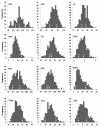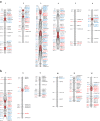QTL analysis of novel genomic regions associated with yield and yield related traits in new plant type based recombinant inbred lines of rice (Oryza sativa L.)
- PMID: 22876968
- PMCID: PMC3438134
- DOI: 10.1186/1471-2229-12-137
QTL analysis of novel genomic regions associated with yield and yield related traits in new plant type based recombinant inbred lines of rice (Oryza sativa L.)
Abstract
Background: Rice is staple food for more than half of the world's population including two billion Asians, who obtain 60-70% of their energy intake from rice and its derivatives. To meet the growing demand from human population, rice varieties with higher yield potential and greater yield stability need to be developed. The favourable alleles for yield and yield contributing traits are distributed among two subspecies i.e., indica and japonica of cultivated rice (Oryza sativa L.). Identification of novel favourable alleles in indica/japonica will pave way to marker-assisted mobilization of these alleles in to a genetic background to break genetic barriers to yield.
Results: A new plant type (NPT) based mapping population of 310 recombinant inbred lines (RILs) was used to map novel genomic regions and QTL hotspots influencing yield and eleven yield component traits. We identified major quantitative trait loci (QTLs) for days to 50% flowering (R2 = 25%, LOD = 14.3), panicles per plant (R2 = 19%, LOD = 9.74), flag leaf length (R2 = 22%, LOD = 3.05), flag leaf width (R2 = 53%, LOD = 46.5), spikelets per panicle (R2 = 16%, LOD = 13.8), filled grains per panicle (R2 = 22%, LOD = 15.3), percent spikelet sterility (R2 = 18%, LOD = 14.24), thousand grain weight (R2 = 25%, LOD = 12.9) and spikelet setting density (R2 = 23%, LOD = 15) expressing over two or more locations by using composite interval mapping. The phenotypic variation (R2) ranged from 8 to 53% for eleven QTLs expressing across all three locations. 19 novel QTLs were contributed by the NPT parent, Pusa1266. 15 QTL hotpots on eight chromosomes were identified for the correlated traits. Six epistatic QTLs effecting five traits at two locations were identified. A marker interval (RM3276-RM5709) on chromosome 4 harboring major QTLs for four traits was identified.
Conclusions: The present study reveals that favourable alleles for yield and yield contributing traits were distributed among two subspecies of rice and QTLs were co-localized in different genomic regions. QTL hotspots will be useful for understanding the common genetic control mechanism of the co-localized traits and selection for beneficial allele at these loci will result in a cumulative increase in yield due to the integrative positive effect of various QTLs. The information generated in the present study will be useful to fine map and to identify the genes underlying major robust QTLs and to transfer all favourable QTLs to one genetic background to break genetic barriers to yield for sustained food security.
Figures


Similar articles
-
Molecular mapping of QTLs for yield related traits in recombinant inbred line (RIL) population derived from the popular rice hybrid KRH-2 and their validation through SNP genotyping.Sci Rep. 2020 Aug 13;10(1):13695. doi: 10.1038/s41598-020-70637-3. Sci Rep. 2020. PMID: 32792551 Free PMC article.
-
Analysis of quantitative trait loci affecting chlorophyll content of rice leaves in a double haploid population and two backcross populations.Gene. 2014 Feb 25;536(2):287-95. doi: 10.1016/j.gene.2013.12.010. Epub 2013 Dec 17. Gene. 2014. PMID: 24361205
-
QTL mapping of grain weight in rice and the validation of the QTL qTGW3.2.Gene. 2013 Sep 15;527(1):201-6. doi: 10.1016/j.gene.2013.05.063. Epub 2013 Jun 11. Gene. 2013. PMID: 23769924
-
2Gs and plant architecture: breaking grain yield ceiling through breeding approaches for next wave of revolution in rice (Oryza sativa L.).Crit Rev Biotechnol. 2024 Feb;44(1):139-162. doi: 10.1080/07388551.2022.2112648. Epub 2022 Sep 29. Crit Rev Biotechnol. 2024. PMID: 36176065 Review.
-
Omics: a tool for resilient rice genetic improvement strategies.Mol Biol Rep. 2022 Jun;49(6):5075-5088. doi: 10.1007/s11033-022-07189-4. Epub 2022 Mar 17. Mol Biol Rep. 2022. PMID: 35298758 Review.
Cited by
-
Combined linkage and association mapping reveal candidate loci for kernel size and weight in maize.Breed Sci. 2019 Sep;69(3):420-428. doi: 10.1270/jsbbs.18185. Epub 2019 Jun 27. Breed Sci. 2019. PMID: 31598074 Free PMC article.
-
Dissecting the Genetic Basis of Yield Traits and Validation of a Novel Quantitative Trait Locus for Grain Width and Weight in Rice.Plants (Basel). 2024 Mar 8;13(6):770. doi: 10.3390/plants13060770. Plants (Basel). 2024. PMID: 38592774 Free PMC article.
-
Non-canonical regulation of SPL transcription factors by a human OTUB1-like deubiquitinase defines a new plant type rice associated with higher grain yield.Cell Res. 2017 Sep;27(9):1142-1156. doi: 10.1038/cr.2017.98. Epub 2017 Aug 4. Cell Res. 2017. PMID: 28776570 Free PMC article.
-
Fine mapping of interspecific secondary CSSL populations revealed key regulators for grain weight at qTGW3.1 locus from Oryza nivara.Physiol Mol Biol Plants. 2024 Jul;30(7):1145-1160. doi: 10.1007/s12298-024-01483-0. Epub 2024 Jul 13. Physiol Mol Biol Plants. 2024. PMID: 39100880 Free PMC article.
-
Characterization of qPL5: a novel quantitative trait locus (QTL) that controls panicle length in rice (Oryza sativa L.).Mol Breed. 2022 Nov 3;42(11):70. doi: 10.1007/s11032-022-01339-z. eCollection 2022 Nov. Mol Breed. 2022. PMID: 37313475 Free PMC article.
References
-
- Khush GS. What it will take to feed 5.0 billion rice consumers in 2030. Pl. Mol Bio. 2005;59:1–6. - PubMed
-
- Doerge RW. Mapping and analysis of quantitative trait loci in experimental populations. Nat Rev Genet. 2001;3:43–51. - PubMed
-
- Falconer DS, Mackay TFC. Introduction to Quantitative Genetics. 4. Longman, Harlow, UK; 1996.
-
- Hittalmani S, Huang N, Courtois B, Venuprasad R, Shashidhar HE, Zhuang JY, Zheng KL, Liu GF, Wang GC, Sidhu JS, Srivantaneeyakul S, Singh VP, Bagali PG, Prasanna HC, McLaren G, Khush GS. Identification of QTL for growth and grain yield-related traits in rice across nine locations of Asia. Theor Appl Genet. 2003;107:679–690. doi: 10.1007/s00122-003-1269-1. - DOI - PubMed
Publication types
MeSH terms
Substances
LinkOut - more resources
Full Text Sources

